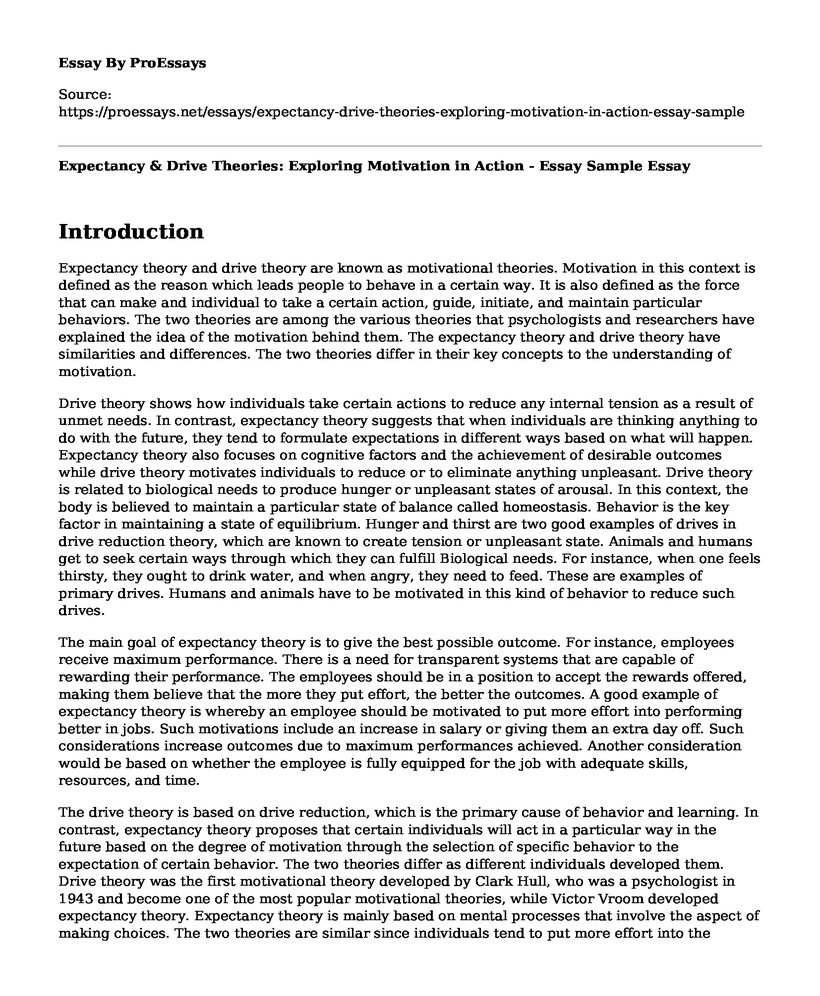Introduction
Expectancy theory and drive theory are known as motivational theories. Motivation in this context is defined as the reason which leads people to behave in a certain way. It is also defined as the force that can make and individual to take a certain action, guide, initiate, and maintain particular behaviors. The two theories are among the various theories that psychologists and researchers have explained the idea of the motivation behind them. The expectancy theory and drive theory have similarities and differences. The two theories differ in their key concepts to the understanding of motivation.
Drive theory shows how individuals take certain actions to reduce any internal tension as a result of unmet needs. In contrast, expectancy theory suggests that when individuals are thinking anything to do with the future, they tend to formulate expectations in different ways based on what will happen. Expectancy theory also focuses on cognitive factors and the achievement of desirable outcomes while drive theory motivates individuals to reduce or to eliminate anything unpleasant. Drive theory is related to biological needs to produce hunger or unpleasant states of arousal. In this context, the body is believed to maintain a particular state of balance called homeostasis. Behavior is the key factor in maintaining a state of equilibrium. Hunger and thirst are two good examples of drives in drive reduction theory, which are known to create tension or unpleasant state. Animals and humans get to seek certain ways through which they can fulfill Biological needs. For instance, when one feels thirsty, they ought to drink water, and when angry, they need to feed. These are examples of primary drives. Humans and animals have to be motivated in this kind of behavior to reduce such drives.
The main goal of expectancy theory is to give the best possible outcome. For instance, employees receive maximum performance. There is a need for transparent systems that are capable of rewarding their performance. The employees should be in a position to accept the rewards offered, making them believe that the more they put effort, the better the outcomes. A good example of expectancy theory is whereby an employee should be motivated to put more effort into performing better in jobs. Such motivations include an increase in salary or giving them an extra day off. Such considerations increase outcomes due to maximum performances achieved. Another consideration would be based on whether the employee is fully equipped for the job with adequate skills, resources, and time.
The drive theory is based on drive reduction, which is the primary cause of behavior and learning. In contrast, expectancy theory proposes that certain individuals will act in a particular way in the future based on the degree of motivation through the selection of specific behavior to the expectation of certain behavior. The two theories differ as different individuals developed them. Drive theory was the first motivational theory developed by Clark Hull, who was a psychologist in 1943 and become one of the most popular motivational theories, while Victor Vroom developed expectancy theory. Expectancy theory is mainly based on mental processes that involve the aspect of making choices. The two theories are similar since individuals tend to put more effort into the realization that there will be rewards. Individual expectancy, instrumentality, and desirability are the key motivating factors in expectancy theory.
Conclusion
Expectancy theory and drive theory are two motivational theories, with some have similarities and differences. Expectancy theory also focuses on cognitive factors and the achievement of desirable outcomes while drive theory motivates individuals to reduce or to eliminate anything unpleasant. Drive theory shows how individuals take certain actions to reduce any internal tension as a result of unmet needs. In contrast, expectancy theory suggests that when individuals are thinking anything of the future, they tend to formulate expectations in different ways based on what will happen. The drive theory is based on drive reduction, which is the major cause of behavior and learning. The expectancy theory proposes that certain individuals will act in a particular way in the future. Drive theory is related to biological needs to produce hunger or unpleasant states of arousal. Expectancy theory is mainly grounded on mental processes that include the aspect of making choices. Expectancy theory is primarily grounded on mental processes that include the aspect of making choices. Both theories exist for motivational purposes, and hence they are highly useful in the field of marketing. They make it easier to identify the future behaviors that are likely to happen and the forces behind the reduction of certain drives like hunger.
Cite this page
Expectancy & Drive Theories: Exploring Motivation in Action - Essay Sample. (2023, May 22). Retrieved from https://proessays.net/essays/expectancy-drive-theories-exploring-motivation-in-action-essay-sample
If you are the original author of this essay and no longer wish to have it published on the ProEssays website, please click below to request its removal:
- Public Employment Agencies Essay
- Why I Am Interested in Being a Physician Assistant Essay
- Nursing Philosophy Paper Example
- Human Resource Management Training Proposal Paper Example
- Essay Sample on Ethical Code in Police Profession
- Hansell's Theory for Unmet Human Needs: Attachments for Success - Essay Sample
- Wages: What Employees Are Entitled To & Companies' Policies - Essay Sample







